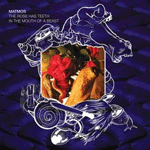|
|
 |
Dusted Reviews
Artist: Matmos Album: The Rose Has Teeth in the Mouth of the Beast Label: Matador Review date: Jun. 27, 2006 |

|
|
|
 |
Sound, in the hands of Matmos, is more than just a series of compression waves propagating through a medium. It’s a physical object that can – no, demands to be manipulated, augmented, extended, and recontextualized in much the same way a visual artist views the individual components of a collage. And while the case could be made that all music based around samples objectifies sound, only Matmos take it to such a level that they actually reverse the conversion: objects become the sounds that are treated as objects.
Lost yet? Having started with such innocuous things as crayfish brainwaves, caged lab rats, liposuction, and marching bands, Drew Daniel and Martin Schmidt have gradually incorporated humans more and more into their sonic miasma. So it makes complete sense that they would start treating human personas as sounds the same way they treat rabbit pelts. Just look at Daniel’s Soft Pink Truth project. Persona is incorporated on two levels: Daniel pretending to be a house DJ, and that house DJ in turn taking on the role of the early-’80s hardcore band, with hilarious (and fantastic) results. And while The Rose Has Teeth in the Mouth of the Beast may not be quite as meta, it is just as obsessed with personality.
Each song is an homage to a person (Darby Crash, for instance). Each person is represented by a set of objects (in this case, hair clippers, hair, a lighter and a cigarette) and, in some cases, people associated with that person (Don Bolles). (Matmos remain incredibly well connected, getting cameo appearances from everyone from Björk to the Kronos Quartet, from Maja Ratkje to Zeena Parkins, from Marcus Schmickler to Laetitia Sonami. And while not all of them are necessarily directly connected to the song they appear on, they still make their presence felt.) Each object is played, recorded, manipulated, and incorporated into the song (Bolles “plays” the cigarette and lighter, causing the “burnt flesh” and “cry of pain” played by Daniel, i.e., Bolles gives Daniel a Germs burn). Each person, object, and method is documented by a postcard for the song that includes a portrait of the person, the performers, their instruments, and a few pictures from the recording process. The objects used are always incorporated into the title of the song (“Germs Burn for Darby Crash”), creating a hermetically sealed construct that is as much a science experiment about each character as it is a portrait. The methodology behind every track is painstakingly notated, especially for “Snails and Lasers for Patricia Highsmith” which has one of their most involved setups ever, using snails and lasers to control a theremin. As always, though, a profoundly silly sense of humor pervades the proceedings, with oddball samples and objects popping up all over the place.
For a band that so often insists it has nothing to do with politics, to the point where they hate to even be asked about it, this album is remarkably political. Around the time of 2003’s The Civil War, they insisted that despite the connotations of their chosen subject matter, there was no political message whatsoever hidden within the blocks of sound beyond the implicit statement of two gay men making oddball electronica (famously epitomized in a 2003 Tonight Show appearance with Björk in which Schmidt ran a contact mic through Daniel’s hair while he processed the sound). Here, however, the politics are plastered throughout their choices of subjects. All embody a kind of liminal sexuality, be it Valerie Solanas’s rabid feminism, James Bidgood’s homoerotic photography, Boyd McDonald’s Straight to Hell zine, or Ludwig II’s, Darby Crash’s, and William Burroughs’s simple existences. To choose such an assortment goes beyond the implicit hints of previous albums, and almost reads as a manifesto of where they see themselves in the world, a kind of alternate history of creative media. It could just be a list of their influences as gay men, or just some ploy to make me, the reviewer, talk myself in circles, but there is no escaping the politics of this music, be it active of passive.
One final thought. Matmos reviews all inherently become lists, a sort of “look what those crazy Matmos kids are doing this time.” The music itself is often a secondary consideration, beyond the fact that it is remarkably well crafted, wonderfully executed, and consistently inventive. Perhaps because of the way they view sound as an object, the sound they create can only be viewed in objective terms, as a list of component parts. Such shortchanging is unjustifiable but unfortunately inevitable. Matmos have created a digital manifestation of their own personality, one that would be done more justice through psychoanalysis than musical description.
By Dan Ruccia
|







